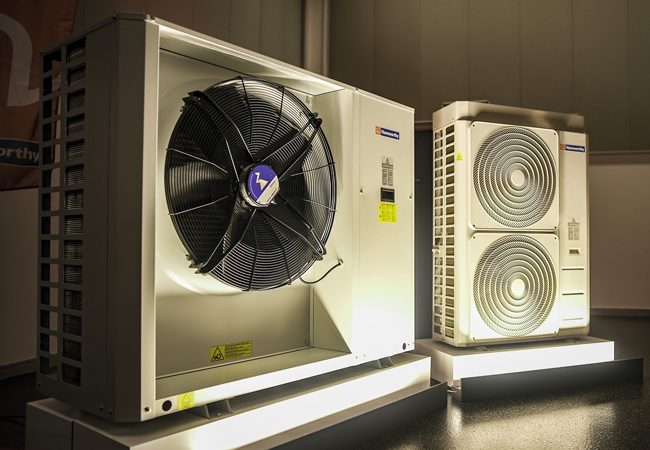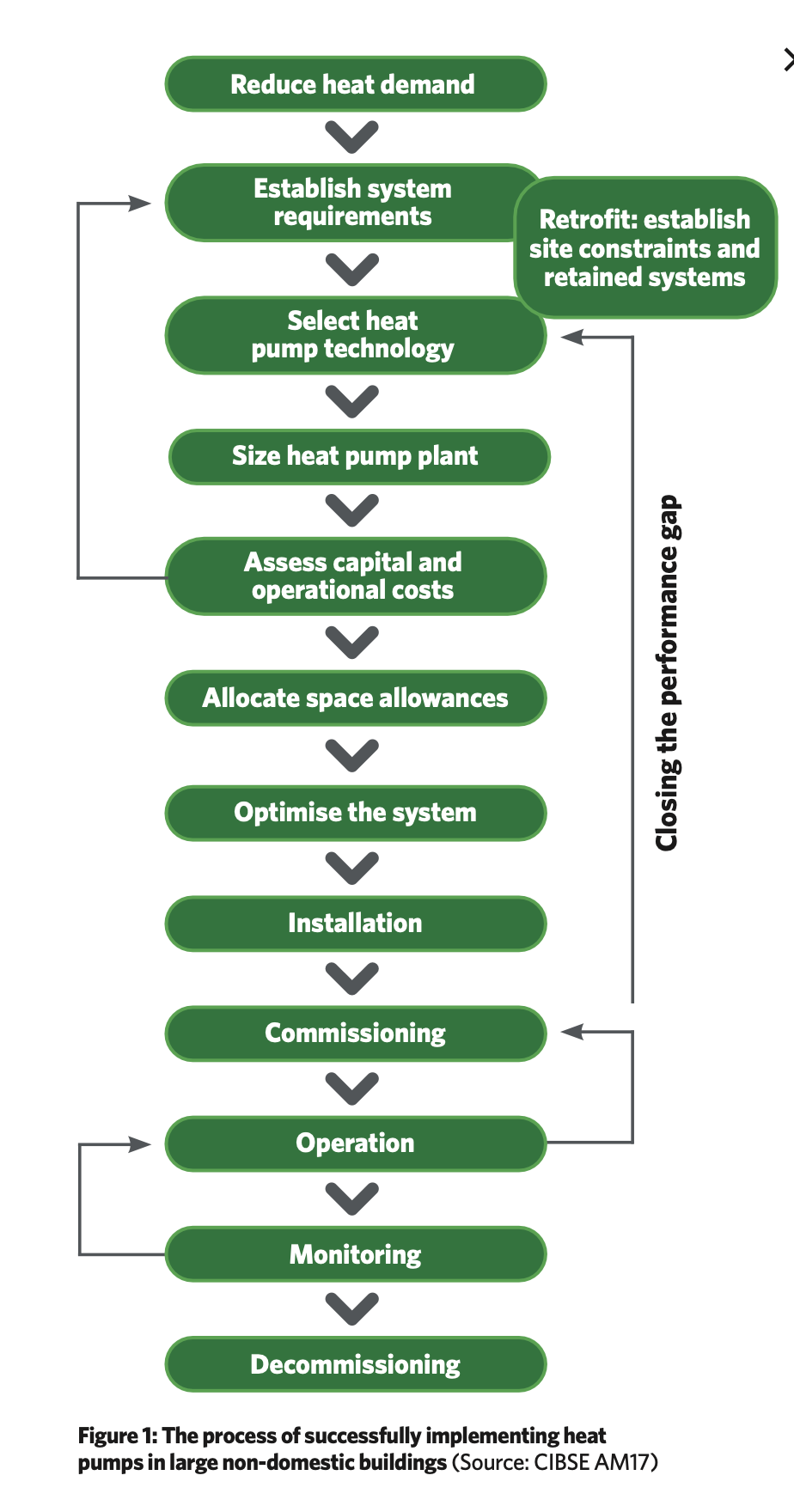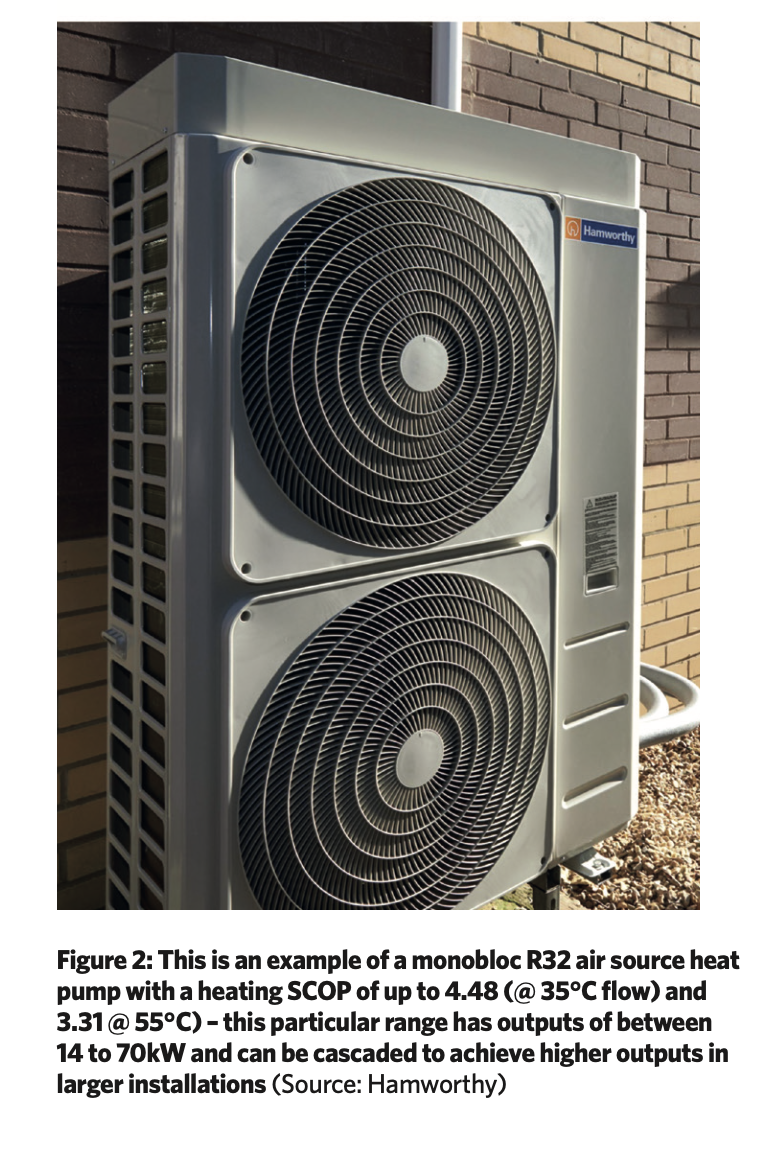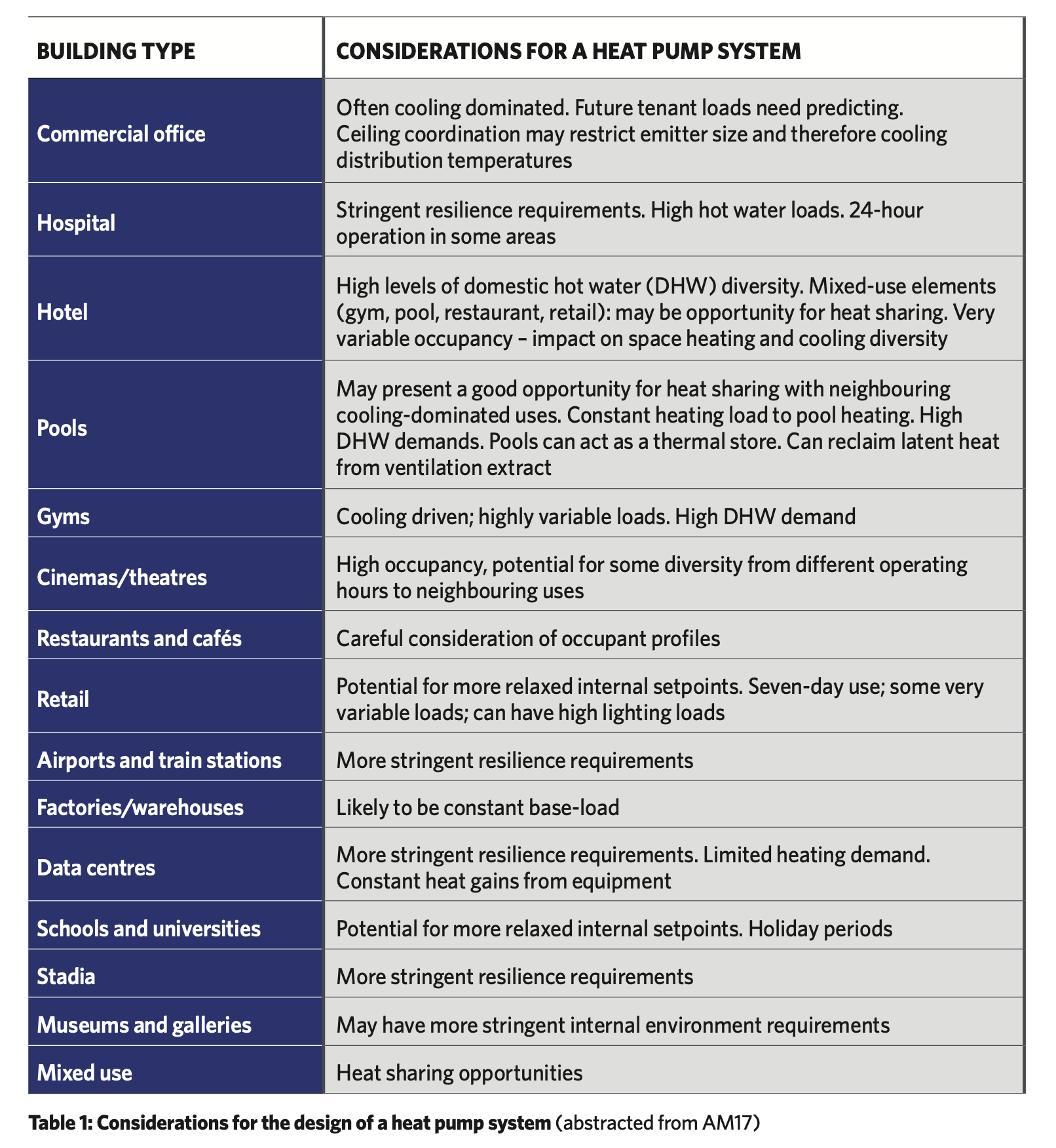

The global drive to reduce building-related emissions and the ambition to achieve net zero by 2050 requires a significant shift in how all buildings are heated and cooled. Decarbonising heating in non-domestic buildings – which account for a large proportion of emissions – will make a significant contribution towards reaching this goal. This CPD article, which draws extensively on elements of the freely-downloadable CIBSE applications manual AM17, explores the early-stage investigations and assessments that will set non-domestic building systems designers, owners and operators on a solid foundation for the development of a heat pump application.
To meet the existing energy and climate pledges worldwide, the International Energy Agency (IEA) reports1 that heat pumps will have to meet nearly 20% of global heating needs in buildings by 2030. IEA considers that the world is almost on track to reach this milestone if new installations continue to grow at a similar rate globally of more than 15% per year, as has been achieved in recent years.
In stark contrast, the recent update2 by the UK government’s Heat Pump Ready initiative – which is, at least currently, focused on accelerating the number of domestic heat pump installations – reported that the UK required an annual compound market growth of 43% per year to deliver the UK government target of 600,000 heat pump installations annually by 2028. (UK growth was reported as being far lower than that in several European states with similar climates.) In its recent report,1 IEA notes that installations of heat pumps remain concentrated in new buildings and existing single-family homes, and that multi-storey apartment buildings and commercial spaces will need to be a priority area if solid growth is to continue.
It is thought that the majority of the heat pumps installed in the UK in 2023 were for domestic applications.2 However, (non-electrical) heating and hot water utilise3 approximately 40% of the energy supplied to UK non-domestic premises, and therefore potentially provide a great opportunity for heat pump applications.
Heat pump technology continues to advance, most recently with the increasing rollout of ‘high temperature’ heat pumps – which typically employ environmentally benign refrigerants such as CO2 and propane. This eases the transition for existing buildings, as well as new developments, to employ heat pumps as the main – or even acting as the sole – heat generator for non-domestic applications.
CIBSE AM17 Heat pumps for large non-domestic buildings serves as a comprehensive guide to support the effective design, installation, commissioning, operation and maintenance of heat pump systems of more than 45kW (see boxout overleaf). AM17 provides a technical commentary encompassing all the assessment and implementation stages of heat pump deployment, as illustrated in Figure 1.

AM17 emphasises the importance of minimising heating and cooling demands before designing a heat pump system. Smaller, more efficient and more affordable heat pumps become possible by reducing peak loads. Ideally, this would include optimising the building form, which is clearly more achievable in new developments.
However, the thermal performance of existing buildings can equally be enhanced by modifications such as improvements in building fabric, greater airtightness, application of thermal mass and appropriate solar shading. Demand-reduction strategies should be holistic, considering both heating and cooling demands throughout the year, while indoor environmental quality and occupant comfort must, of course, remain crucial considerations when attempting to reduce demands. The total embodied carbon of building improvements must be balanced against the reduced carbon footprint of a smaller heat pump system.
The optimisation of building thermal performance not only benefits the building owner, but also reduces the strain on the electricity grid and the knock-on impact on surrounding developments. It is recognised that not all buildings, especially those with heritage constraints, can implement every demand-reduction measure, but design teams should consider such strategies wherever possible. The process of optimisation is likely to be iterative, as various packages of interdependent building and system parameters will need to be explored to provide the best solution for a particular application.
The appropriate sizing and selection of heat pumps – such as the monobloc unit illustrated in Figure 2 – that can meet the heating demands of the building is key to avoid shortcomings in terms of capital and operational costs, space, noise, efficiency and life-cycle emissions. The fundamental requirement is to examine the loads and temporal zonal load profiles, considering intended use, building usage patterns, plus factors including fresh air ventilation rates, internal design conditions and any process loads. AM17 notes that standard methods of load estimation are provided in CIBSE Guide A4 and BS EN 12831-1:2017.5

Dynamic thermal modelling and simulations (which are increasingly enabled through a data-rich BIM model) can provide useful intelligence around loads and time-dependent profiles that inform scenario and sensitivity analysis to help understand the potential impact of varying building parameters. This could include such areas as building construction details; operational setpoints; optimised, adaptive ventilation methods; and the integration of thermal storage.
Careful use of adaptive and weather-compensated internal design conditions can provide significant load reductions (as long as the system finally installed is appropriately controlled). Any analysis should reflect impending climate scenarios by employing appropriate future weather files that account for potential shifts in temperature and precipitation. For existing buildings, co-heating tests, metered data and tenant information may be used to aid the prediction of future loads. Annual, daily, and hourly profiles can reveal periods of simultaneous heating and cooling, as a means of establishing an understanding of peak instantaneous load. CIBSE TM546 provides methodologies for the estimation of the annual energy consumption in buildings.
When selecting and sizing the central heat pump system, diversity factors for zonal and occupational demands are likely to have a more significant impact on oversizing than with traditional fossil-fuel systems. It is important to take a measured approach to the impact of future tenant loads, as being over-generous with future allowances could lead to an oversized and probably less efficient system. Domestic hot water demands are notably challenging to predict, and the demand should be diversified according to an appropriate standard for the application. For a discussion of the issues associated with this, see CIBSE Technical Bulletin No 1.7

Non-commercial buildings that have high domestic hot water use – for example, hotels, multi-residential developments, restaurants, healthcare facilities and leisure centres – require particular care, as assumptions made at the early stages of design can be overturned with later system selections that can significantly impact the previously expected performance of the building thermal systems. Systems should be planned for variations in demand as different parts of a development are occupied, as well as to cater for future building needs.
Understanding how often the system is likely to perform at part-load and mid-load will help inform designers and operators how the systems are likely to operate prior to full building occupation or during periods of unpredictable and fluctuating usage patterns. Each type of building, and each application, will have specific needs. AM17 provides a high-level summary of some of considerations required for a selection of building types, shown in Table 1, that illustrates the need for careful consideration of specific applications.
CIBSE AM17: Heat pump installations for large non-domestic buildings
This freely downloadable CIBSE application manual, published in 2022, serves as a valuable resource for building services designers, installers, operators and maintainers, providing comprehensive guidance and best practice for the successful implementation of large heat pump systems in non-domestic buildings. By following the recommendations and guidelines outlined in this document, stakeholders can ensure efficient, reliable and sustainable heat pump systems that contribute to energy savings, reduced carbon emissions and improved indoor environmental quality.
The guidance encompasses new and existing buildings, and is aimed at systems with a thermal output exceeding 45kW that might be used to provide one or more of the services needs of a building, including space heating, cooling, domestic hot water and process heat. Although the applications are tailored specifically to the UK context and regulations, the engineering principles are universal and provide an excellent starting point for those considering applying heat pumps for non-domestic purposes rather than in single family homes.
AM17 is available at bit.ly/CJApr24CPD1. For a free PDF, use code ‘AM17’.
Systems are typically designed with some resilience that permits operation while, for example, individual heat generators (and associated sub-systems) are maintained or repaired; when buildings experience surge heating or cooling loads; or simply to accommodate a need to reduce building heat-up times. Careful analysis is required to establish the optimum arrangement of heat pump units and thermal storage to deliver the most effective solution.
Thermal storage is increasingly employed to maximise the heat exchange between cold and hot water generation, which can significantly improve operational efficiency. This can be particularly effective where there are coincident heating and cooling demands, such as domestic hot water on a summer day when space cooling is required; where different zones of the building have disparate heating and cooling demands; or possibly where there is an opportunity to balance heating or cooling process loads. Temporal storage can be an asset, particularly in areas with mild climates, allowing time-shifting of loads to provide greatest overall efficiencies by storing either high- or low-temperature heat.
Any analysis of the requirements for thermal storage should be based on hourly modelling and include the impact stores have on overall heat losses and heat sharing capacity. Heat pump effectiveness will deteriorate with excessive on-off cycling, as clearly demonstrated for domestic applications in the 2012 report by Robert Green.8 This can be significantly reduced through having sufficient thermal capacity in the water distribution system and associated thermal stores. In commercial systems employing multiple, properly sized and staged heat pumps, excessive cycling should not be a significant problem.
If there is a desire, or a need, to employ bivalent or multivalent systems – where loads are shared with, for example, fossil fuel boilers, direct electrical heaters, water chillers and solar thermal collectors – then an assessment must be undertaken to determine the proportion of the loads that will be provided by each technology. This may be relatively simple if, for example, a gas boiler is providing top-up heating for a low-temperature heat pump to ensure legionella-safe domestic hot water, but, otherwise, further iterative analysis will be needed that will include assumptions of the future system selection and design.
Bivalent solutions have been relatively common with low-temperature heat pumps (where higher temperatures have been required to meet the loads); however, as heat pumps evolve to effectively provide higher flow temperatures, this is likely to become less of a technical issue. Lower hot water and higher chilled water temperatures will tend to improve heat pump performance, as well as reduce distribution thermal losses. In turn, these will also impact components and their performance – including pipe sizes, pumps, heat emitters and heat exchangers – so will add a further level of complexity to the optimisation process.
A well-designed and installed heat pump system can provide significant cost savings compared with traditional heating and cooling systems. However, proper system design, installation, commissioning, operation and maintenance are crucial to ensure optimal performance, energy efficiency and longevity of heat pump systems. Without an appropriate foundation of assessment and analysis, it is unlikely that the installed solution will provide the desired – and essential – decarbonisation that can otherwise be delivered by heat pump applications.
References:
- bit.ly/CJApr24CPD2 – accessed 1 March 2024.
- bit.ly/CJApr24CPD3 – accessed 10 March 2024.
- Building Energy Efficiency Survey (BEES), UK BEIS, 2016.
- CIBSE Guide A.
- BS EN 12831-1:2017: Energy performance of buildings. Method for calculation of the design heat load, BSI 2017.
- CIBSE TM54: Evaluating operational energy use at the design stage, CIBSE 2022.
- CIBSE Technical Bulletin 01: Domestic water demand assessment for pipe sizing.
- Green, R, The effects of cycling on heat pump performance, UK DECC, 2012.

